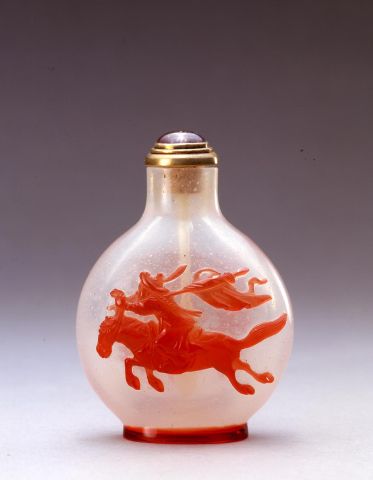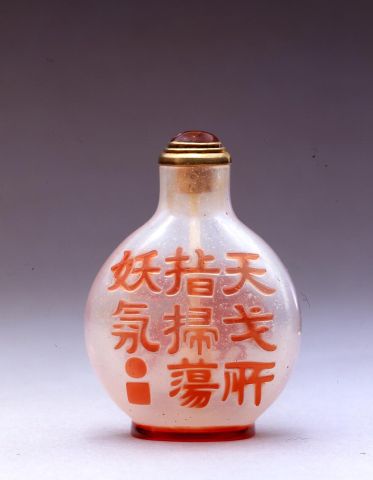

Bottle ID: 00261
CLEAR W/RED OVERLAY, MANCHU BANNER-MAN & SCRIPT
Date: 1759-1795
Height: 53 mm
Glass, of flattened rounded shape with sloping shoulders, overlaid with ruby-red on a cloudy bubble ground and carved on one side with a galloping Manchu banner-man, his banner flying over his shoulder, the other side with an eight character couplet in regular script reading: 'Wherever the imperial army is directed, it wipes out all anomalous and evil aura', followed by two blank seals, one circular, one square, and with a neatly carved footrim.
Imperial, attributed to the Palace Workshops, Beijing.
Similar Examples:
Crane Collection no. 72
Gengqi, Xia; Rong Zhang. Masterpieces of Snuff Bottles in the Palace Museum, 1995, p. 95, no. 82.
Moss, Hugh, Victor Graham and Ka Bo Tsang. The Art of the Chinese Snuff Bottle - The J & J Collection, 1993, Vol. 2, p. 623, no. 375.
Kleiner, Robert W. L. Chinese Snuff Bottles from the Collection of Mary and George Bloch, 1987, p. 81, no. 112.
Hall, Robert. Chinese Snuff Bottles II, 1989, p. 69, no. 50.
Provenance:
Hugh Moss [HK] Ltd.
Exhibited:
Annual Convention ICSBS Toronto, October 2007
An imperial attribution on this bottle has been given on the basis of comparison with the first example cited above from the Palace Museum, Beijing. While the majority of overlay glass bottles with inscriptions on one main side of the body seem to be carved within a circular overlay panel, this small group of bottles has no such restriction. Part of the reason for this may be in the design with the addition of two seals at the end of the inscription. While most of the seals on examples in private collections are of the same format - a round seal above a square seal - the example in the Beijing Palace Museum is carved with the two characters. Both seals were presumably intended to be incised by the eventual owner of the bottle. Blank seals on Palace bottles in particular, may represent bottles intended as gifts from the Emperor where the seals could be added by the recipient. They occur not only on glass, but on a number of jade examples attributable to the Imperial Workshops. It is interesting that a red overlay glass bottle from the O'Dell Collection (Ford, John Gilmore, Chinese Snuff Bottles, The Edward Choate O'Dell Collection, 1982, pp. 58-59, No. 129) is carved with a dragon on one side and a similarly carved, high relief, eight character inscription using ancient Zhou seal characters, 'the dragon is flying in the sky, it is opportune to see personages in high positions', together with a round seal above a square seal. An example in the Bloch Collection, (Moss, Hugh, Victor Graham, and Ka Bo Tsang, A Treasury of Chinese Snuff Bottles, Vol. 5, Part 3, pp. 558-561, No. 940) using a milk-white overlay on a clear blue ground uses the seals to provide a date for the bottle to the gengzi year. Although this is a cyclical date, it is likely to be 1780 as an earlier date is too early and sixty years later unlikely.
The 'J & J' example cited above has exactly the same inscription although the translation is somewhat different and rather cumbersome - 'The finger of Heaven's majesty makes a clean sweep of evil influence'. The Bloch example has the same translation as the 'J & J' example but a slightly different inscription, with the second character being entirely different.
The Manchus during the Qing dynasty were empire building, expanding not only southward into China, but also westward to include the mountains and the deserts. The Jesuits in the Palace often produced not only maps of the conquered lands, but also historical paintings of battles. Giuseppe Castiglione for example, painted various depictions of mounted banner-men and warriors, such as the painting on paper of 'Ma Chang Attacking the Enemy Camp' (Palace Museum, Taipei). It is from such fine paintings as these that designs for snuff bottles may have been taken. Specifically, it is generally accepted that on bottles, the design represents the Emperor Qianlong's victory in the conquest of Xinjiang in 1759, allowing us a starting point for the dating of these bottles. However, it is difficult to give this early a dating to the same portrayal on the more common agate bottles, which are more easily placed in the first half of the nineteenth century.
In the Crane example above, the depiction of the banner-man is vigorous, looking as though the rider is galloping away with as much energy as he can muster, on his mission to wipe out evil!

 English
English 中文
中文